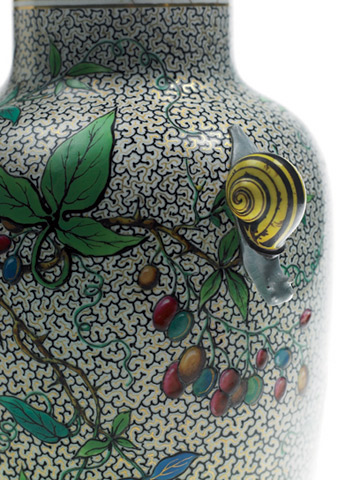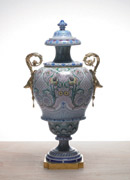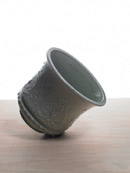Following the presentation of the works of the 1950s in 2006, and then the production of the 1920/1930s last year, the Manufacture nationale de Sèvres pursues the exploration of its prestigious history by presenting the production of the second half of the XIXth century. Between the long and fruitful administration of Alexandre Brongniart (who died in 1847) and the radical stylistic transformations of Art nouveau, the production that goes from 1848 to 1896, spanning the Second Empire and the IIIrd Republic, still remains misunderstood. By including pieces often shown for the first time, on loan from the Mobilier national, the Musée des arts et métiers, les Arts décoratifs, the estate of the castle of Compiègne and the National Museum of ceramics, the exhibition gives us the opportunity to look at this period under a different light.
The Second Empire, a prosperous period
When Napoleon III arrived to power, scholar Victor Regnault was named to head the Manufacture. The Institution was on the Emperor’s Civil List, was allowed to continue using its craftsmanship methods, carry out technical and artistic experiences and present remarkable pieces at the universal exhibitions that punctuated the period. Strengthened by the Emperor’s support, and by the great number of pieces he bought –among the most beautiful - for his own use or to give as presents, the institution went through a very prosperous period. There were nearly three hundred persons, the highest number of all its history. They once again manufactured soft paste porcelain; they set up a workshop for earthenware and glazed clay, another for enamels on metal; the technique of pâte-sur-pâte (paste on paste) was perfected; the taste for the isolated motive imposed itself. These initiatives were undoubtedly encouraged by the new interest aroused in the XVIIIth century in decorative arts and by Empress Eugenie’s personal taste.
Illustration: Rimini vase, 1865 Hard paste porcelain, golden bronze H. 1,18 m, L. 68 cm Mobilier national (Inv. GML 919/1)
The decorations, half way between tradition and modernity
Most of the pieces made then in soft paste took on shapes from the factory’s collections, whether vases or service pieces. They were often decorated with copies of old paintings (Boucher, Fragonard or Greuze, among others). Nevertheless, certain decorators were already looking for more modernity. In any case, these productions – very few in comparison to the hard paste porcelain pieces – allowed Sèvres to play an important role in the rediscovery and the recognition of old techniques fallen into abeyance. The factory thus played one of the roles it had been assigned, that of helping private companies by carrying out the long and expensive research of which it generously communicated the results. As of 1849, it was believed the factory should move, as its first buildings at Sèvres were too cramped. The construction works lagged and when Maréchal de Mac-Mahon officially inaugurated the site on 17 November 1879, only a few workshops and the Museum were ready.
Under the Third Republic, new inspirations
Between 1879 and 1891, the factory supplied the various State services with common pieces, meant to be used as presents, lots or trophies. These objects, most of the time vases, were generously spread around and gave a completely erroneous image of the Sèvres production although they only represented a small part of the work, and by far the least inventive. As of 1879, varied stylistic research was indeed carried out, under the impulse of the director of art works, Albert Carrier-Belleuse, who used both experienced painters as well as a new generation of artists trained at the school that opened in the Manufacture itself. Aside from the influence of the Renaissance, in particular through Carrier-Belleuse, that of China and Japan, fed by the universal expositions, was also strongly felt. The openness to new tendencies can also be measured by the important part the factory played in the development of photography. Victor Regnault, the director as of 1852, photographed the landscapes of Sèvres and became the first president of the French Photograph Society. Louis Robert, the head of the decoration workshops, created a priceless documentary fund on the Manufacture by taking shots of his colleagues, of the ancient models exposed at the Museum and of the new creations.
Illustration: Brézin vase, 1898 Thick porcelain H. 38 cm, D. 43 cm Manufacture nationale de Sèvres
PUBLICATION:
Sèvres, Second Empire & IIIe République, de l’audace à la jubilation, (Sèvres, Second Empire & IIIrd Republic, from audacity to jubilation) Collection Sèvres, une histoire céramique, Editions courtes et longues, 144 pages, 100 four-color illustrations, 24,3 x 28 cm, 35 €.
To see more illustrations, click on VERSION FRANCAISE at the top
of this page
|










